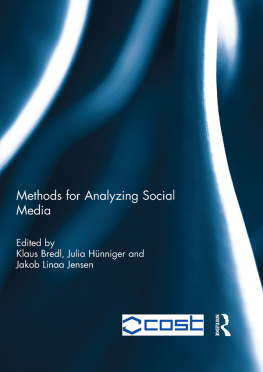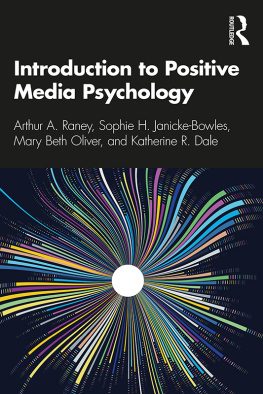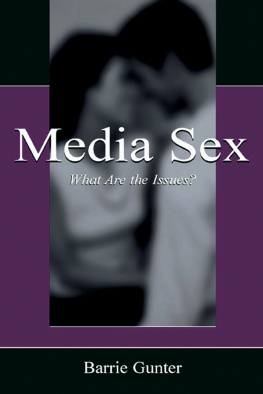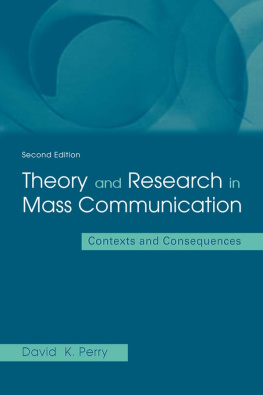Media Choice
This timely collection represents the next generation of research in media psychology, bridging selective exposure to a larger framework of choice in media usage. Considering the myriad media options available, this work seeks to answer such questions as: What mechanisms guide an individuals exposure to/choice of media? How can researchers model them?
Editor Tilo Hartmann provides a thorough overview of various perspectives on media choice, offering a foundation to stimulate new research initiatives. Contributors to the work include top-notch scholars from the United States and Europe, representing the current state of research in this area.
This volume will be of great interest to scholars utilizing a psychological approach to media study, and it will be relevant to researchers seeking a state-of-the-art overview about the field or who are interested in a systematized look at the research conducted in the past.
Tilo Hartmann, Ph.D., is an Assistant Professor in the Department of Communication Science at the VU University, Amsterdam. Previous affiliations include positions at the Hanover University of Music and Drama, the University of Southern California, the University of Erfurt, the Institute of Mass Communication and Media Research, and the University of Zurich. His research interests focus on media use, in particular selective exposure, reception, and effects.
Media Choice
A Theoretical and Empirical Overview
Edited by Tilo Hartmann

NEW YORK AND LONDON
First published 2009
by Routledge
270 Madison Ave, New York, NY 10016
Simultaneously published in the UK
by Routledge
2 Park Square, Milton Park, Abingdon, Oxon OX14 4RN
Routledge is an imprint of the Taylor & Francis Group, an informa business
This edition published in the Taylor & Francis e-Library, 2009.
To purchase your own copy of this or any of Taylor & Francis or Routledges collection of thousands of eBooks please go to www.eBookstore.tandf.co.uk.
2009 Taylor & Francis
All rights reserved. No part of this book may be reprinted or reproduced or utilized in any form or by any electronic, mechanical, or other means, now known or hereafter invented, including photocopying and recording, or in any information storage or retrieval system, without permission in writing from the publishers.
Trademark Notice: Product or corporate names may be trademarks or registered trademarks, and are used only for identification and explanation without intent to infringe.
Library of Congress Cataloging-in-Publication Data
Media choice : a theoretical and empirical overview/[edited] by Tilo Hartmann.
p. cm.
1. Mass mediaSocial aspects. 2. Mass mediaPsychological aspects. 3. Choice (Psychology) I. Hartmann, Tilo.
HM1206.M3894 2008
306.4'6--dc22
2008027006
ISBN13: 978-1-135-92506-2 ePub ISBN
ISBN10: 0-415-96456-3 (hbk)
ISBN10: 0-415-96458-X (pbk)
ISBN10: 0-203-93865-8 (ebk)
ISBN13: 978-0-415-96456-2 (hbk)
ISBN13: 978-0-415-96458-6 (pbk)
ISBN13: 978-0-203-93865-2 (ebk)
Contents
TILO HARTMANN
|
ROBERT LAROSE
|
TILO HARTMANN
|
MARINA KRCMAR AND YULIYA STRIZHAKOVA
|
HELMUT SCHERER AND TERESA K. NAAB
|
JENS WOLLING
|
JULIAN N. MAREWSKI, MIRTA GALESIC, AND GERD GIGERENZER
|
WOLFGANG DONSBACH
|
MATTHIAS R. HASTALL
|
MARY BETH OLIVER
|
ANDREAS FAHR AND TABEA BCKING
|
HELENA BILANDZIC
|
JAMES G. WEBSTER
|
CEES M. KOOLSTRA, UTE RITTERFELD, AND PETER VORDERER
|
ALAN R. DENNIS, ROBERT M. FULLER, AND JOSEPH S. VALACICH
|
THILO VON PAPE
|
Figures
2.1 | Path Analysis of Social Cognitive Model of Internet Usage |
2.2 | Socio-cognitive Model of Broadband Adoption |
3.1 | The Theories of Reasoned Action and Planned Behavior |
6.1 | Quality Perception and Transfer |
6.2 | Calculating the QA for the Desired Features |
6.3 | Calculating the QA for the Undesired Features |
6.4 | Logical Weaknesses in the Multiplication Approach of the Expectancy Value Theory |
6.5 | The Structure of Quality Dimensions as a Comparative Concept |
7.1 | How Does the Recognition Heuristic Work? |
8.1 | Intervening Variables in the Course of Dissonance Research |
8.2 | Logic of the Unit of Analysis |
8.3 | Differential Effects of Dissonance for Positive and Negative Information |
9.1 | Basic Assumptions of the Informational Utility Model by Atkin |
9.2 | Assumptions of the Informational Utility Model by Knobloch-Westerwick, Hastall, Grimmer, and Brck |
9.3 | Selective Exposure to Positive and Negative News Combined as Function of Informational Utility |
11.1 | Affect as Moderating Factor in the Gratification Discrepancy Model |
15.1 | Media Synchronicity Theory Implications for Media Choice |
15.2 | Communication System and Media Capabilities |
16.1 | Adoption Curve |
Tables
5.1 | Types of Costs in the Communication Process |
7.1 | Hypothetical Movie Environment |
11.1 | Factor Analysis: Reasons for Program Avoidance |
15.1 | Communication Process Characteristics |
15.2 | Comparison of Selected Media and their Capabilities |
Contributors
Helena Bilandzic, Ph.D., Assistant Professor at the University of Erfurt in Germany. Research interests include media use, cultivation, narrative persuasion, qualitative and quantitative methodology.
Tabea Bcking, Ph.D., Assistant Professor at the Ludwig-Maximilians-University Munich. Interests include framing research, search engines and new media, media choice, and methodological issues.
Alan R. Dennis, Professor of Information Systems. Holds the John T. Chambers Chair of Internet Systems in the Kelley School of Business at Indiana University. His research interests include team collaboration, knowledge management, and the Internet.
Wolfgang Donsbach, Professor of Communication and founding director of the Department of Communication at Dresden University of Technology, Germany. He has taught at the universities of Dortmund, Mainz and Berlin in Germany, and was a visiting professor at Syracuse University (USA), University of Navarra (Spain), and Harvard University. He has been president of the World Association for Public Opinion Research (19951996) and the International Communication Association (20042005). Donsbach has been managing editor of the










